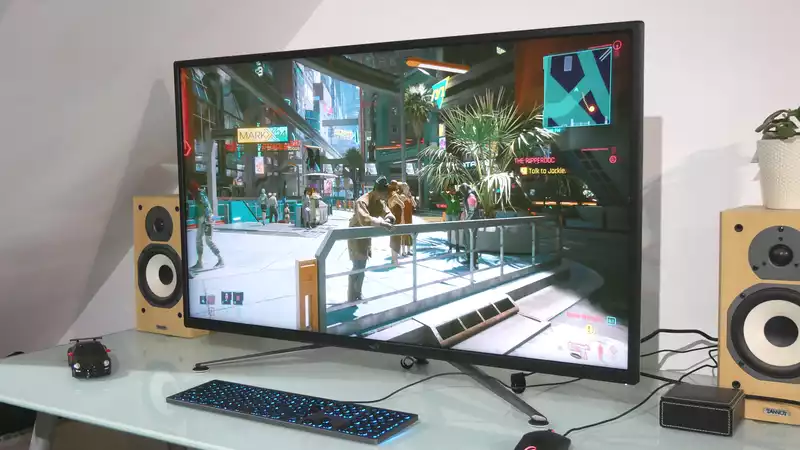Remember when VA was the panel technology that dared not speak its name for the game? Long story short, you had to choose between unsightly smear or an awful level of pixel overshoot due to overdrive. Yikes. Either way, the pixel response was often ugly.
Recently, several gaming monitor manufacturers, including Samsung, have cleaned up this situation: VA monitors are decently fast, and ASUS' new ROG Strix XG43UQ is here. This thing is a beast.
The key stats start with the massive 43-inch 4K panel with 3,840 x 2,160 pixels. It delivers a full 144 Hz, which is not uncommon these days, but still impressive when paired with 4K. Even more unusual, it runs at a high refresh rate not only via DisplayPort but also via HDMI, with two HDMI 2.1 sockets supporting 120Hz at 4K.
This is obviously ideal for console gaming. However, HDMI 2.1 support is only available on the latest hard-to-find Nvidia RTX 30 series and AMD RX 6000 boards. The use case here is tag-teaming a PC with an Xbox Series X or Sony PS5. [It supports both AMD FreeSync and Nvidia G-Sync, as well as VRR compatibility for pesky consoles. Next up is the ASUS ROG Strix XG43UQ, which delivers 1,000 nits peak brightness and is VESA DisplayHDR 1000 certified. This Asus monster will surely be a prime candidate.
In addition, it has a VA panel with a pixel response time of 1 ms. This response combined with 144Hz refresh not only bodes well with respect to speed, but also suggests that this is a brave new generation of high-speed VA panels. Add to that a rather funky, albeit overtly game-like design, and this is a very promising package.
Unfortunately, there are some fatal flaws. The first flaw is HDR performance; despite its 1,000 nits of backlight power and HDR1000 rating, this is not a true HDR monitor. The reason for this lies in the local dimming feature that the ASUS ROG Strix XG43UQ nominally offers.
Asus does not cite the exact number of zones, probably because this is an edge-lit monitor and the number is not going to be impressive. In other words, it does not have a full array backlight, and dimming is, after all, fairly pointless. On the other hand, VA panels have a super strong inherent contrast of 4,000:1. As such, dynamic range is actually quite good for a non-genuine HDR monitor. However, it is a real shame to find an HDR1000 monitor without full array dimming.
Of course, the ASUS ROG Strix XG43UQ is treated as a punchy SDR monitor. Incredibly bright with strong colors and excellent contrast, the CyberPunk 2077 at full reheat is truly stunning, with only one fairly serious problem: the monitor's pixel response. Pixel Response.
Asus has at least five user-configurable pixel overdrive levels that can be selected in the OSD menu. Part of the problem is that at level 3, overshoot and reverse ghosting are fairly obvious problems. At level 5, it is catastrophic. On the other hand, turning down the overdrive or turning it off completely results in very poor response and obvious blurring. Even with the overdrive turned up, it is not terribly good. There are 5 year old VA monitors that have better response than this. I have one.
As a last resort, you could try Asus' ELMB (Extreme Low Motion Blur) technology. But instead of fixing things, this would just triple-vision mess up the picture quality of the XG43UQ. It's a rather hopeless and pointless feature on this particular panel, and one might wonder how this is possible given the spec of 1ms response time, but that's the MPRT figure, which stands for Moving Picture Response Time. MPRT is actually very misleading, despite the fact that it is a measure of response intended to give a more realistic picture of panel performance. This is certainly the case here. [ASUS ROG Strix XG43UQ uses a BGR sub-pixel layout instead of RGB. Admittedly, this is not really relevant for gaming. However, it does affect Windows font rendering, which relies on the traditional sub-pixel structure for ClearType font smoothing technology. It also suggests that this monitor is actually an HDTV panel and is based on an older one.
All of this unfortunately makes the ASUS ROG Strix XG43UQ an unusually and ultimately fatally flawed gaming monitor, which is a shame because the HDR certification falsification is debatable, but the still image quality is actually quite impressive. However, the poor pixel response is inexcusable on any kind of gaming monitor, much less one this expensive.
.

Comments